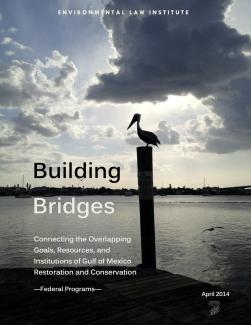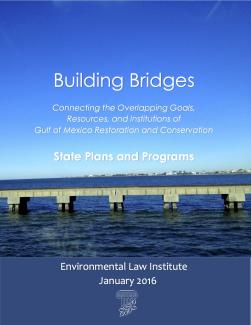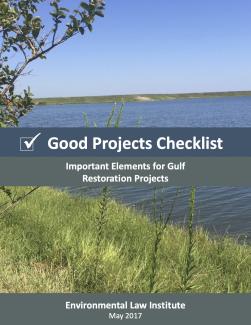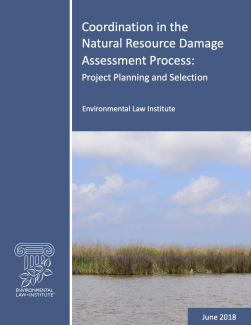ELI Report
Wetland Woes: Institute publishes a series of guides on improving the restoration of vital aquatic ecosystems in the U.S.
Wetlands perform irreplaceable ecosystem services, from improving water quality, preventing shoreline erosion, to providing habitat for threatened and endangered species. Since 1990, the Clean Water Act’s Section 404 program has aimed to achieve a “no net loss” of aquatic ecosystems in the United States. Any project that will result in fill or disturbance to a wetland or stream—for example, constructing a neighborhood or a store, or building a road or bridge—must obtain a permit from the U.S. Army Corps of Engineers. To issue that permit, the Corps must first determine that any potential impacts have been avoided or minimized as much as possible. And for the unavoidable impacts that remain, developers must then offset them through restoration activities.
This practice of offsetting the remaining impacts is called compensatory mitigation. Permittees restore any lost acres and functions by conducting projects to restore, rehabilitate, establish, or enhance wetlands, streams, and other aquatic resources. Permittees can either implement these activities on their own, or pay a mitigation bank or in-lieu fee (ILF) program to offset impacts on their behalf—an option called third-party compensatory mitigation.
Many are surprised to learn that compensatory mitigation is a multi-billion dollar market. Under these programs, tens of thousands of wetlands and streams are restored each year. ELI has been studying the compensatory mitigation program for decades, producing numerous resources designed to improve the implementation of the program.
In August 2021, the Institute released a series of comprehensive guides in partnership with the Institute for Biodiversity Law and Policy at Stetson University College of Law on improving implementation of ILF programs—one of two third-party compensatory mitigation options. The guides cover some of the most challenging components of ILF program implementation identified through extensive research and interviews with ILF programs and other stakeholders. They help address a number of perennial problems by identifying specific challenges, providing detailed recommendations on ways to meet these challenges, and highlighting case studies to illustrate effective approaches.
Each of the four guides explores a regulatory requirement that programs need to fulfill. One is “full-cost accounting”—regulations stipulate that ILF providers must set fees in a way that proactively anticipates and accounts for all costs associated with mitigation. Many programs face challenges in determining these costs, due in part to a lack of information on what costs to include and how to estimate them.
Another guide addresses common delays in project approval processes, which are required for third-party mitigation options like ILF programs. A third guide covers long-term management, a practice in which ILF programs are required to sustain mitigation projects in perpetuity once completed. The report covers strategies for the effective planning and implementation that these long-term sites require.
Finally, a fourth guide provides information on what to expect from programmatic audits, which help provide confidence to regulators, purchasers, and the public that a given ILF program is meeting its requirements and successfully offsetting permitted impacts. The report includes guidance on what information programs should include in their program instruments, model language for audit provisions, and how programs can prepare for such audits.
ILF programs account for close to 20 percent of the nation’s compensatory mitigation. Together with other third-party options, ILF programs oversee some of the nation’s largest, most ecologically valuable sites. ELI continues to work closely with compensatory mitigation practitioners and regulators to research best practices and strengthen the protection of U.S. wetlands, streams, and aquatic ecosystems.
 Report on high-seas regulations provides input to UN treaty
Report on high-seas regulations provides input to UN treaty
The vast majority of the world’s oceans, including the high seas and deep seabed, are areas beyond national jurisdiction—meaning no one nation holds sole authority. As advances in technology open up possibilities for commercial activities in the high seas, concern is growing that these areas will experience rapid industrialization. One way to ensure that development is conducted in an environmentally sustainable manner is to establish regulatory procedures for ocean industries.
The United Nations draft agreement for the protection of marine biodiversity in areas beyond national jurisdiction, or the UN BBNJ treaty, aims to do just that. The treaty proposes to, among other things, implement requirements for developers to conduct environmental impact assessments (EIA) on proposed industrial facilities in the high seas so that the significant biodiversity of these areas will be protected. But as the treaty itself moves beyond initial development to implementation of EIA and other protections, practitioners around the world remain wondering: “How can we ensure that EIA is done effectively once the BBNJ language is signed into international law?”
In December 2021, ELI published Implementation of EIA in Areas Beyond National Jurisdiction Under the UN BBNJ Agreement: Next Steps in EIA Guidelines, a report to help illuminate the practitioner’s perspective to the UN BBNJ process. The report synthesizes the discussions of a working group convened by ELI, composed of more than 25 senior officials with expertise in international law and ocean policy, environmental management, and EIA.
The document, authored by ELI Visiting Scholar Patience Whitten as part of the Institute’s Blue Growth Law and Governance Initiative, identifies key challenges to the successful implementation of an EIA regime as proposed under the UN draft agreement, and provides input to further the goals of the treaty.
ELI is developing this work as part of a multi-year research and collaboration effort to ensure a meaningful implementation of EIA principles in the high seas.
Clearinghouse connects communities with pro bono legal services
In February, ELI launched its Pro Bono Clearinghouse, an initiative that connects communities experiencing environmental injustices with attorneys who can provide pro bono legal services. ELI’s Pro Bono Clearinghouse is a venue for sharing opportunities and identifying expertise to support communities with pressing environmental problems. The Clearinghouse works to ensure that communities with viable environmental legal matters get the representation they need—whether in a courtroom, in front of an agency, or in a more facilitative or consultative fashion.
Environmental clinics are forced to turn down countless cases each year due to a lack of resources. At the Clearinghouse, clinics, partner NGOs, or ELI staff post a community’s request for a pro bono attorney with the right qualifications and notify environmental lawyers about ongoing pro bono opportunities. Law clinics can also create postings to find local counsel or legal support on specialized issues to expand internal capacity. Attorneys can in turn search for opportunities that match with their time availability, legal expertise, and jurisdiction of practice.
All attorneys who are ELI members can opt in to access the Clearinghouse and posted matters. Each attorney is required to review the available courses from the ELI Continuing Legal Education on Community Lawyering for Environmental Justice program, an ongoing series of training sessions provided in conjunction with the Clearinghouse. The classes enable attorneys opting into the platform to gain skills in community lawyering, a key practice in meaningful EJ-oriented pro bono work. Community lawyering centers on prioritizing the needs of communities and collaborating with individuals and groups as facilitative partners.
Law firms with ELI membership can opt in to the Clearinghouse, and non-lawyers and students are encouraged to contribute research, writing, scientific expertise, and other skills in conjunction with pro bono attorneys. All clinics and communities that post matters can also access the Clearinghouse to reach thousands of environmental practitioners within ELI’s network and collaborating partners.
The Clearinghouse partners with groups including the American Bar Association’s Section of Environment, Energy, and Resources, the American College of Environmental Lawyers, the Environmental Protection Network, and the Chesapeake Legal Alliance. The Clearinghouse also partners with two world-class, community-focused nonprofits: the Anthropocene Alliance, the country’s largest coalition of communities on the frontline of environmental justice, and the Thriving Earth Exchange, which connects communities with pro bono scientists.
Law clinics in the United States and around the world are welcome to join. Lawyers, law students, environmental experts, and advocates may connect with the Clearinghouse at probono@eli.org and at eli.org/probono.
Institute Published Guide on Restoring Wetlands




